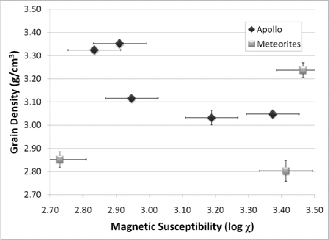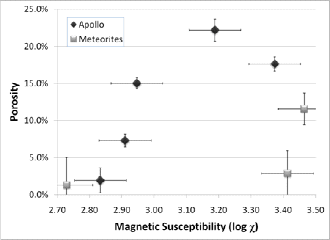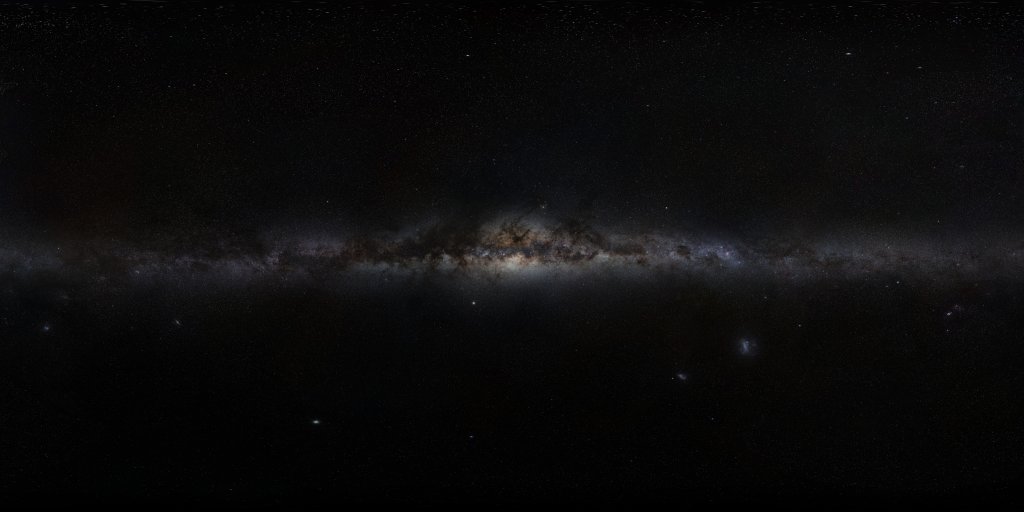|
41st Lunar and Planetary Science Conference (2010) - Page 1: (Click here for Official PDF Version)
DENSITY, POROSITY AND MAGNETIC SUSCEPTIBILITY OF LUNAR ROCKS. R. J. Macke1, W. S.
Kiefer2, D. T. Britt1, and G. J. Consolmagno3; 1University of Central Florida, 4000 Central Florida Blvd., Orlando
FL 32816 [email protected], 2Lunar and Planetary Institute, 3600 Bay Area Blvd., Houston TX 77058, 3Specola
Vaticana, V-00120 Vatican City State.
|
|
Introduction: Observations of the Moon�s gravity
and topography by Lunar Prospector and Kaguya [1-3]
provide important constraints on the Moon�s internal
structure. Ongoing work by Lunar Reconnaissance
Orbiter as well as by GRAIL in a few years will continue
to sharpen our knowledge of the Moon�s gravity
and topography. In order to use this flood of data to
understand the Moon�s interior, it is necessary to have
a comprehensive data base of lunar rock densities and
porosities. Many density measurements were reported
in the first few years after the Apollo landings, but
Talwani et al. [4] concluded that more than half of
these measurements have uncertainties exceeding 10%,
which makes the measurements useless for geophysical
modeling. Many other measurements do not document
the measurement method and uncertainty. Another essential
parameter is rock porosity. For example, in Kiefer�s
gravity model of the Marius Hills volcanic field
[5], the uncertainty in the model results is dominated
by uncertainty in the crustal porosity. Very few measurements
of lunar rock porosity exist in the literature.
We know of only 11 Apollo samples that have well
documented measurements of both density and porosity
made on the same sample [6-10]. Here, we report new
density and porosity measurements for 5 Apollo samples
and 3 lunar meteorites. These new measurements
are a significant increment in our total data base for
lunar rock properties.
Measurement: Our methods, originally developed
for meteorite research, are outlined in [11]. They are
fast, non-destructive and non-contaminating. Grain
density is measured by helium ideal-gas pycnometry.
Bulk density is measured by the glass bead method
developed by [12]. We used beads of average diameter
750 µm, large enough to be easily seen by the unaided
eye and removed easily from the sample after completion
of measurement. Porosity is calculated directly
from bulk and grain densities: (bulk grain) P=1-(P bulk/P grain).
Magnetic susceptibility is measured with a handheld
SM-30 magnetic susceptibility meter, and corrected for
sample geometry according to the calibration by [13].
We measured five fragments taken from Apollo
samples. 12051 is an ilmenite basalt from the Surveyor
crater [14a]. 14303 and 14321 are crystalline-rich
breccias from Frau Mauro [14b,c]. 15418 is a granulitic
breccia [14d], and 15555 is a basalt [14e]. These
samples range in mass from 10.0 to 33.0 g. We also
|
|
Table 1: Grain and bulk densities of lunar samples.
| NAME |
Mass
(g) |
Pgrain
(g/cm3) |
Pbulk
(g/cm3) |
| A 12051, 19 |
12.19 |
3.32 ± 0.02 |
3.26 ± 0.05 |
| A 14303, 14 |
22.26 |
3.05 ± 0.01 |
2.51 ± 0.03 |
| A 14321, 220 |
10.01 |
3.03 ± 0.03 |
2.36 ± 0.04 |
| A 15418, 179 |
28.68 |
3.12 ± 0.01 |
2.65 ± 0.02 |
| A 15555, 62 |
32.98 |
3.35 ± 0.01 |
3.11 ± 0.03 |
| NWA 482 |
9.87 |
2.85 ± 0.03 |
2.82 ± 0.10 |
| NWA 773 |
13.22 |
3.24 ± 0.03 |
2.86 ± 0.06 |
| NWA 5000 |
7.00 |
2.80 ± 0.05 |
2.72 ± 0.07 |
Table 2: Porosities and magnetic susceptibilities of lunar samples.
| NAME |
Mass
(g) |
Porosity
(%) |
Mag. Susc.
(log X) |
| A 12051, 19 |
12.19 |
1.9 ± 1.7 |
2.83 ± 0.08 |
| A 14303, 14 |
22.26 |
17.6 ± 1.0 |
3.37 ± 0.8 |
| A 14321, 220 |
10.01 |
22.2 ± 1.5 |
3.19 ± 0.08 |
| A 15418, 179 |
28.68 |
15.0 ± 0.07 |
2.95 ± 0.08 |
| A 15555, 62 |
32.98 |
7.3 ± 0.9 |
2.91 ± 0.08 |
| NWA 482 |
9.87 |
1.3 ± 3.7 |
3.41 ± 0.08 |
| NWA 773 |
13.22 |
11.6 ± 2.2 |
3.46 ± 0.08 |
| NWA 5000 |
7.00 |
2.9 ± 3.1 |
2.73 ± 0.08 |
measured three fragments of lunar meteorites (all breccias):
Northwest Africa [NWA] 482 (9.87g), NWA
773 (13.22g) and NWA 5000 (7.00g). Data are
represented in tables 1 and 2.
Discussion: Lunar basalts usually have a high concentration
of Fe and thus are considerably denser than
terrestrial basalts. Lunar basalts are typically classified
by their Ti abundance, and sometimes also by other
elements such as Al and Mg [15,16]. Titanium is particularly
important because of the high density of ilmenite.
Prior studies of lunar basalts include 5 high Ti
basalts [6, 8, 9] and only one low Ti basalt [7]. The
basalts measured here, 12051 and 15555, are both low
Ti basalts. One of the long term objectives of our study
is to be able to use remote sensing observations [e.g.,
17, 18] to constrain plausible basalt densities in various
locations and thus improve the quality of regional gravity
models. To do this, additional measurements of the
full range of lunar basalt compositions, including intermediate
Ti, high Mg, and high Al basalts, are
needed.
|
|
41st Lunar and Planetary Science Conference (2010) - Page 2: (Click here for Official PDF Version)
|

Figure 1: Grain density vs. magnetic susceptibility for lunar samples.
Samples 14303 and 14321 are from the Fra Mauro
formation, which is Imbrium basin ejecta. The samples
were collected about 1 km apart and have essentially
identical grain densities and only slightly different porosities.
Chung et al. [19] measured the bulk density of
another split of 14321. Our result matches theirs within
measurement uncertainty. Because of the importance of
basin ejecta across much of the Moon�s surface, additional
measurements of samples from other basins are
needed, including the Descartes and Cayley formations
at Apollo 16 and the Imbrium and Serenitatis rims at
Apollos 15 and 17.
The Moon�s upper crust is believed to be dominantly
anorthosite, changing to norite in the lower crust
[20]. Sample 15418 is a brecciated gabbroic anorthosite,
approximately 70% plagioclase. Our measured
bulk density is about 5% less than two measurements
on other splits of 15418 [21,22]. 15418 is visually heterogeneous
[23], and our sample may differ slightly in
either composition or porosity from the previously
measured samples. 15418�s porosity, 15%, is similar to
the 18-20% measured on lunar anorthosite 60025 [24].
The grain density of anorthosite NWA 5000 is similar
to 60025 [10].
An intriguing observation is that two of the lunar
meteorites, NWA 482 (an impact melt breccia) and
NWA 5000, have very low porosities. This is consistent
with earlier measurements by point counting,
which measures porosity but not density, on other lunar
meteorites [24]. This may mean that impact ejection of
material from the Moon is easiest for low porosity
rocks. NWA 773 is a regolith breccia dominated by
clasts of olivine gabbro [25]. The strength of the clasts
may have permitted ejection despite its higher porosity.
Acknowledgments: Apollo samples were provided
on loan by NASA Johnson Space Center, Lunar Sample
|
|

Figure 2: Porosity vs. magnetic susceptibility for lunar samples.
Collection. Lunar meteorite access was provided
by: (NWA 5000) Arthur Ehlmann at Texas Christian
University; (NWA 482) Carl Agee and Jim Karner at
the Institute of Meteoritics, University of New Mexico;
and (NWA 773 � sample BM2001,M23) Caroline
Smith at the Natural History Museum, London UK.
This work was supported by grant NNX09AD91G
from the NASA Planetary Geology and Geophysics
Program.
References: [1] Konopliv et al. (2001) Icarus 150,
1-18. [2] Namiki et al. (2009) Science 323, 900-905.
[3] Araki et al. (2009) Science 323, 897-900. [4] Talwani
et al. (1973) in Apollo 17 Preliminary Science
Report. [5] Kiefer, this conference. [6] Fujii and Osako
(1973) EPSL 18, 65-71. [7] Horai and Winkler (1975)
Proc. Lunar Sci. Conf. 6, 3207-3215. [8] Horai and
Winkler (1976) Proc. Lunar Sci. Conf. 7, 3183-3204.
[9] Horai and Winkler (1980) LPS XI, 1777-1788. [10]
Jeanloz and Ahrens (1978) LPS IX, 2789-2803. [11]
Consolmagno et al. (2008) Chemie der Erde � Geochem.
68, 1-29. [12] Consolmagno and Britt (1998)
Meteorit. Planet. Sci. 33, 1231-1241. [13] Gattacceca
et al. (2004) Geophys. J. Int. 158, 42-49. [14] Meyer,
({a} 2005; {b,c,e} 2009; {d} 2008) Lunar Sample
Compendium. [15] Neal and Taylor (1992) GCA 56,
2177-2211 [16] Papike et al. (1998) in Planetary Materials,
Rev. Mineralogy 36. [17] Prettyman et al.
(2006) JGR 111, E12007. [18] Lucey (2004) GRL 31,
L08701. [19] Chung et al. (1972) Proc. Lunar Sci.
Conf. 3, 3161-3172. [20] Wieczorek et al. (2006) in
New Views of the Moon, Rev. Mineralogy 60, 2006.
[21] Todd et al. (1972) Proc. Lunar Sci. Conf. 3, 2577-
2586. [22] Ahrens et al. (1973) Proc. Lunar Sci. Conf.
4, 2575-2590. [23] Nord et al. (1977) The Moon 17,
217-231. [24] Warren (2001) JGR 106, 10,101-10,111.
[25] Joliff et al. (2003) GCA 67, 4857-4879.
|
|

